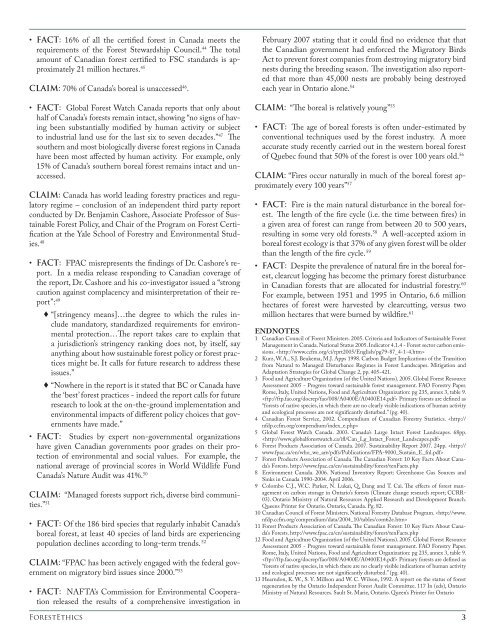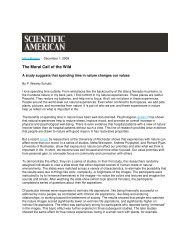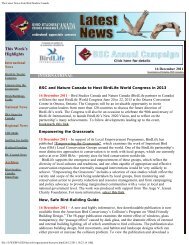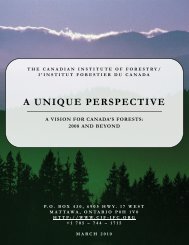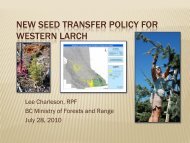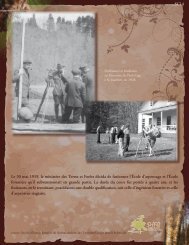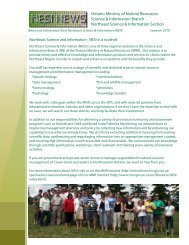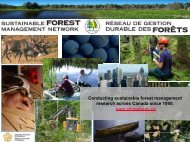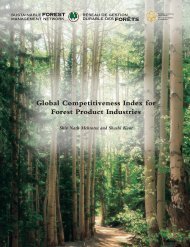Canada's Forest Industry: Setting the Record Straight - Canadian ...
Canada's Forest Industry: Setting the Record Straight - Canadian ...
Canada's Forest Industry: Setting the Record Straight - Canadian ...
Create successful ePaper yourself
Turn your PDF publications into a flip-book with our unique Google optimized e-Paper software.
• FACT: 16% of all <strong>the</strong> certified forest in Canada meets <strong>the</strong>requirements of <strong>the</strong> <strong>Forest</strong> Stewardship Council. 44 The totalamount of <strong>Canadian</strong> forest certified to FSC standards is approximately21 million hectares. 45CLAIM: 70% of Canada’s boreal is unaccessed 46 .• FACT: Global <strong>Forest</strong> Watch Canada reports that only abouthalf of Canada’s forests remain intact, showing “no signs of havingbeen substantially modified by human activity or subjectto industrial land use for <strong>the</strong> last six to seven decades.” 47 Thesou<strong>the</strong>rn and most biologically diverse forest regions in Canadahave been most affected by human activity. For example, only15% of Canada’s sou<strong>the</strong>rn boreal forest remains intact and unaccessed.CLAIM: Canada has world leading forestry practices and regulatoryregime – conclusion of an independent third party reportconducted by Dr. Benjamin Cashore, Associate Professor of Sustainable<strong>Forest</strong> Policy, and Chair of <strong>the</strong> Program on <strong>Forest</strong> Certificationat <strong>the</strong> Yale School of <strong>Forest</strong>ry and Environmental Studies.48• FACT: FPAC misrepresents <strong>the</strong> findings of Dr. Cashore’s report.In a media release responding to <strong>Canadian</strong> coverage of<strong>the</strong> report, Dr. Cashore and his co-investigator issued a “strongcaution against complacency and misinterpretation of <strong>the</strong>ir report”:49♦ “[stringency means]…<strong>the</strong> degree to which <strong>the</strong> rules includemandatory, standardized requirements for environmentalprotection…The report takes care to explain thata jurisdiction’s stringency ranking does not, by itself, sayanything about how sustainable forest policy or forest practicesmight be. It calls for future research to address <strong>the</strong>seissues.”♦ “Nowhere in <strong>the</strong> report is it stated that BC or Canada have<strong>the</strong> ‘best’ forest practices - indeed <strong>the</strong> report calls for futureresearch to look at <strong>the</strong> on-<strong>the</strong>-ground implementation andenvironmental impacts of different policy choices that governmentshave made.”• FACT: Studies by expert non-governmental organizationshave given <strong>Canadian</strong> governments poor grades on <strong>the</strong>ir protectionof environmental and social values. For example, <strong>the</strong>national average of provincial scores in World Wildlife FundCanada’s Nature Audit was 41%. 50CLAIM: “Managed forests support rich, diverse bird communities.”51• FACT: Of <strong>the</strong> 186 bird species that regularly inhabit Canada’sboreal forest, at least 40 species of land birds are experiencingpopulation declines according to long-term trends. 52CLAIM: “FPAC has been actively engaged with <strong>the</strong> federal governmenton migratory bird issues since 2000.” 53• FACT: NAFTA’s Commission for Environmental Cooperationreleased <strong>the</strong> results of a comprehensive investigation in<strong>Forest</strong>EthicsFebruary 2007 stating that it could find no evidence that that<strong>the</strong> <strong>Canadian</strong> government had enforced <strong>the</strong> Migratory BirdsAct to prevent forest companies from destroying migratory birdnests during <strong>the</strong> breeding season. The investigation also reportedthat more than 45,000 nests are probably being destroyedeach year in Ontario alone. 54CLAIM: “The boreal is relatively young” 55• FACT: The age of boreal forests is often under-estimated byconventional techniques used by <strong>the</strong> forest industry. A moreaccurate study recently carried out in <strong>the</strong> western boreal forestof Quebec found that 50% of <strong>the</strong> forest is over 100 years old. 56CLAIM: “Fires occur naturally in much of <strong>the</strong> boreal forest approximatelyevery 100 years” 57• FACT: Fire is <strong>the</strong> main natural disturbance in <strong>the</strong> boreal forest.The length of <strong>the</strong> fire cycle (i.e. <strong>the</strong> time between fires) ina given area of forest can range from between 20 to 500 years,resulting in some very old forests. 58 A well-accepted axiom inboreal forest ecology is that 37% of any given forest will be olderthan <strong>the</strong> length of <strong>the</strong> fire cycle. 59• FACT: Despite <strong>the</strong> prevalence of natural fire in <strong>the</strong> boreal forest,clearcut logging has become <strong>the</strong> primary forest disturbancein <strong>Canadian</strong> forests that are allocated for industrial forestry. 60For example, between 1951 and 1995 in Ontario, 6.6 millionhectares of forest were harvested by clearcutting, versus twomillion hectares that were burned by wildfire. 61Endnotes1 <strong>Canadian</strong> Council of <strong>Forest</strong> Ministers. 2005. Criteria and Indicators of Sustainable <strong>Forest</strong>Management in Canada. National Status 2005. Indicator 4.1.4 - <strong>Forest</strong> sector carbon emissions.2 Kurz, W.A., S.J. Beukema, M.J. Apps 1998. Carbon Budget Implications of <strong>the</strong> Transitionfrom Natural to Managed Disturbance Regimes in <strong>Forest</strong> Landscapes. Mitigation andAdaptation Strategies for Global Change 2, pp. 405-421.3 Food and Agriculture Organization (of <strong>the</strong> United Nations). 2005. Global <strong>Forest</strong> ResourceAssessment 2005 - Progress toward sustainable forest management. FAO <strong>Forest</strong>ry Paper.Rome, Italy, United Nations, Food and Agriculture Organization: pg 235, annex 3, table 9. Primary forests are defined as“forests of native species, in which <strong>the</strong>re are no clearly visible indications of human activityand ecological processes are not significantly disturbed.” (pg. 40).4 <strong>Canadian</strong> <strong>Forest</strong> Service, 2002. Compendium of <strong>Canadian</strong> <strong>Forest</strong>ry Statistics. 5 Global <strong>Forest</strong> Watch Canada. 2003. Canada’s Large Intact <strong>Forest</strong> Landscapes. 68pp.6 <strong>Forest</strong> Products Association of Canada. 2007. Sustainability Report 2007. 24pp. 7 <strong>Forest</strong> Products Association of Canada. The <strong>Canadian</strong> <strong>Forest</strong>: 10 Key Facts About Canada’s<strong>Forest</strong>s. http://www.fpac.ca/en/sustainability/forest/tenFacts.php8 Environment Canada. 2006. National Inventory Report: Greenhouse Gas Sources andSinks in Canada 1990-2004. April 2006.9 Colombo C.J., W.C. Parker, N. Lukai, Q. Dang and T. Cai. The effects of forest managementon carbon storage in Ontario’s forests (Climate change research report; CCRR-03). Ontario Ministry of Natural Resources Applied Research and Development Branch.Queens Printer for Ontario. Ontario, Canada. Pg. 82.10 <strong>Canadian</strong> Council of <strong>Forest</strong> Ministers. National <strong>Forest</strong>ry Database Program. 11 <strong>Forest</strong> Products Association of Canada. The <strong>Canadian</strong> <strong>Forest</strong>: 10 Key Facts About Canada’s<strong>Forest</strong>s. http://www.fpac.ca/en/sustainability/forest/tenFacts.php12 Food and Agriculture Organization (of <strong>the</strong> United Nations). 2005. Global <strong>Forest</strong> ResourceAssessment 2005 - Progress toward sustainable forest management. FAO <strong>Forest</strong>ry Paper.Rome, Italy, United Nations, Food and Agriculture Organization: pg 235, annex 3, table 9. Primary forests are defined as“forests of native species, in which <strong>the</strong>re are no clearly visible indications of human activityand ecological processes are not significantly disturbed.” (pg. 40).13 Hearndon, K. W., S. V. Millson and W. C. Wilson, 1992. A report on <strong>the</strong> status of forestregeneration by <strong>the</strong> Ontario Independent <strong>Forest</strong> Audit Committee. 117 In (eds), OntarioMinistry of Natural Resources. Sault St. Marie, Ontario. Queen’s Printer for Ontario


